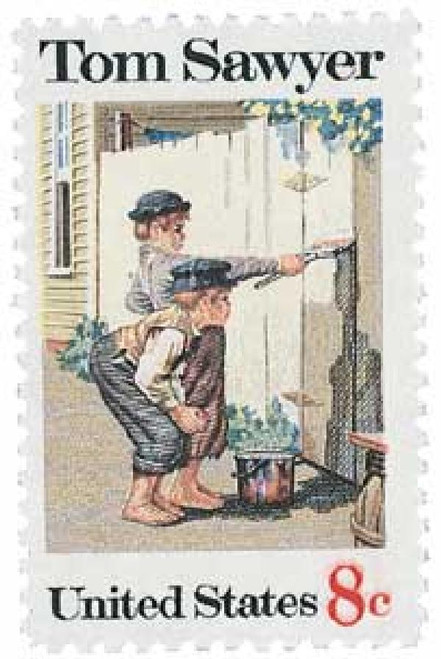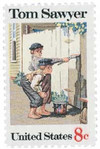
# 1470d - 1972 8c Tom Sawyer
U.S. #1470d Tagging Omitted
8¢ Tom Sawyer
American Folklore Series
Issue Date: October 13, 1972
City: Hannibal, MO
Printed By: Bureau of Engraving and Printing
Printing Method: Lithographed, engraved
Perforations: 11
Color: Multicolored
This stamp salutes Tom Sawyer, who "lived" along the Mississippi River about 1845. Created by Mark Twain, Tom represented the typical adventurous American boy. Twain, who settled in Hannibal, Missouri, as a child, also wrote Huckleberry Finn.
Mark Twain (1835-1910)
Author and Humorist
Mark Twain was the pen name of Samuel L. Clemens, one of the greatest American fiction writers and widely considered America’s greatest humorist. He took the name “Mark Twain” from a riverboat term meaning “two fathoms.” Twain was born in Florida, Missouri, but his family soon settled in the town of Hannibal. In that town, Twain developed his love of the Mississippi River. He eventually became a riverboat captain. Twain is best remembered for the books Tom Sawyer and Huckleberry Finn. In these stories, the fictional town of St. Petersburg was modeled after Hannibal.
Twain developed a distinctly American style of writing. Many writers have imitated his language and tone, which give the impression of real speech. Legendary author Ernest Hemingway once stated, “All modern American literature comes from... Huckleberry Finn.”
Now you can own this stamp with rare tagging omitted. Did you know a stamp missing its phosphorescent tagging is considered by many to be similar to a missing color error? The good news is that unlike some error stamps, untagged error stamps are affordable.
What is Phosphorescent Tagging and Why is it Important?
Tagging of U.S. stamps was introduced in 1963 with airmail stamp #C64a. It helps the U.S. Post Office use automation to move the mail at a lower cost. A virtually invisible phosphorescent material is applied either to stamp ink or paper, or to stamps after printing. This “taggant” causes each one to glow in shades of green (red on older airmails) for a moment after exposure to short-wave ultraviolet (UV) light. The afterglow makes it possible for facing-canceling machines to locate the stamp on the mail piece, and properly position it for automated cancellation and sorting.
Some stamps have been printed with and without tagging intentionally, but when tagging is omitted by accident, we collectors are treated to a scarce modern color error. Our stamp experts examined thousands of stamps to find these just for you. Now you can easily give your error collection a boost or explore this fascinating new area of collecting. Quantities are limited, so order your untagged error stamp right away.
And find more tagging omitted stamps here.
U.S. #1470d Tagging Omitted
8¢ Tom Sawyer
American Folklore Series
Issue Date: October 13, 1972
City: Hannibal, MO
Printed By: Bureau of Engraving and Printing
Printing Method: Lithographed, engraved
Perforations: 11
Color: Multicolored
This stamp salutes Tom Sawyer, who "lived" along the Mississippi River about 1845. Created by Mark Twain, Tom represented the typical adventurous American boy. Twain, who settled in Hannibal, Missouri, as a child, also wrote Huckleberry Finn.
Mark Twain (1835-1910)
Author and Humorist
Mark Twain was the pen name of Samuel L. Clemens, one of the greatest American fiction writers and widely considered America’s greatest humorist. He took the name “Mark Twain” from a riverboat term meaning “two fathoms.” Twain was born in Florida, Missouri, but his family soon settled in the town of Hannibal. In that town, Twain developed his love of the Mississippi River. He eventually became a riverboat captain. Twain is best remembered for the books Tom Sawyer and Huckleberry Finn. In these stories, the fictional town of St. Petersburg was modeled after Hannibal.
Twain developed a distinctly American style of writing. Many writers have imitated his language and tone, which give the impression of real speech. Legendary author Ernest Hemingway once stated, “All modern American literature comes from... Huckleberry Finn.”
Now you can own this stamp with rare tagging omitted. Did you know a stamp missing its phosphorescent tagging is considered by many to be similar to a missing color error? The good news is that unlike some error stamps, untagged error stamps are affordable.
What is Phosphorescent Tagging and Why is it Important?
Tagging of U.S. stamps was introduced in 1963 with airmail stamp #C64a. It helps the U.S. Post Office use automation to move the mail at a lower cost. A virtually invisible phosphorescent material is applied either to stamp ink or paper, or to stamps after printing. This “taggant” causes each one to glow in shades of green (red on older airmails) for a moment after exposure to short-wave ultraviolet (UV) light. The afterglow makes it possible for facing-canceling machines to locate the stamp on the mail piece, and properly position it for automated cancellation and sorting.
Some stamps have been printed with and without tagging intentionally, but when tagging is omitted by accident, we collectors are treated to a scarce modern color error. Our stamp experts examined thousands of stamps to find these just for you. Now you can easily give your error collection a boost or explore this fascinating new area of collecting. Quantities are limited, so order your untagged error stamp right away.
And find more tagging omitted stamps here.







